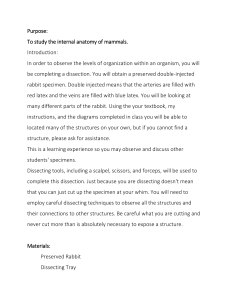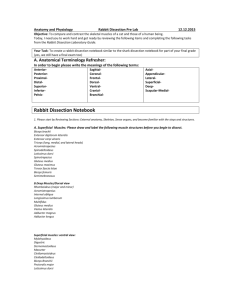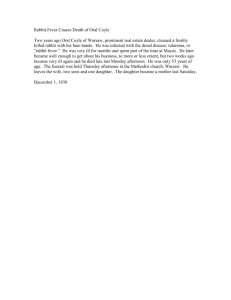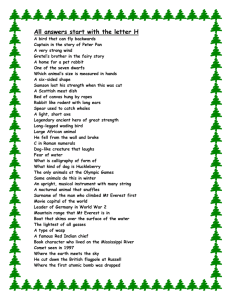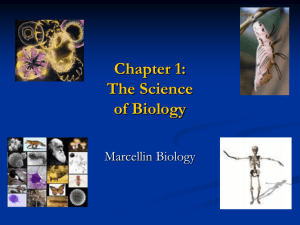Rabbit Dissection Lab: Anatomy Guide for High School Students
advertisement
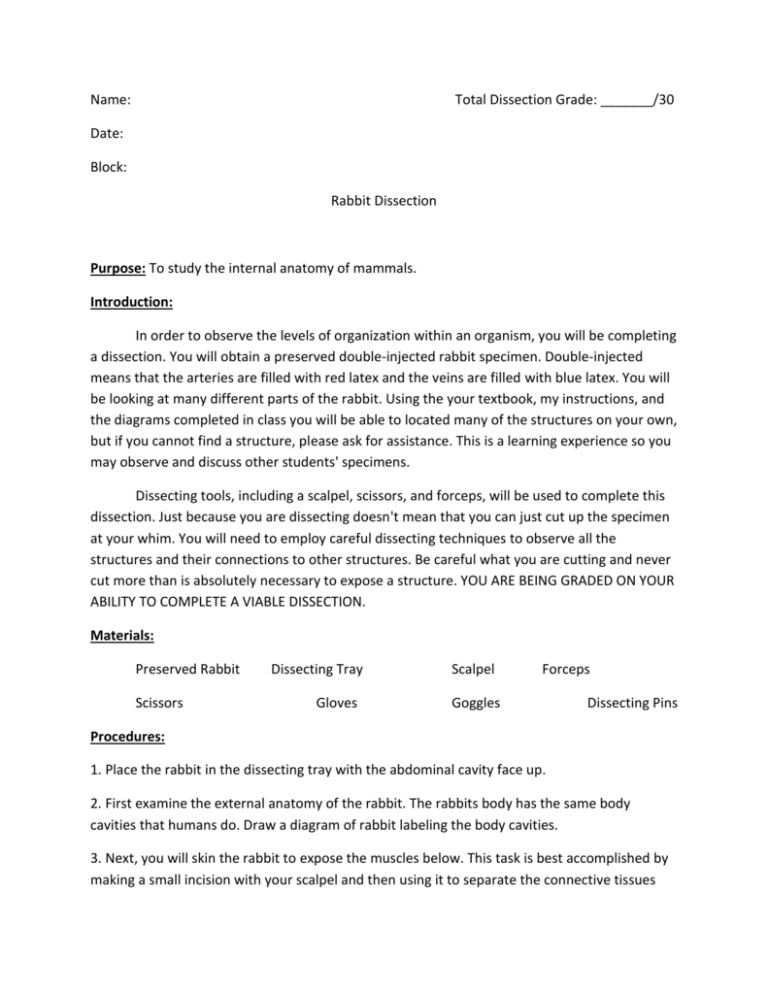
Name: Total Dissection Grade: _______/30 Date: Block: Rabbit Dissection Purpose: To study the internal anatomy of mammals. Introduction: In order to observe the levels of organization within an organism, you will be completing a dissection. You will obtain a preserved double-injected rabbit specimen. Double-injected means that the arteries are filled with red latex and the veins are filled with blue latex. You will be looking at many different parts of the rabbit. Using the your textbook, my instructions, and the diagrams completed in class you will be able to located many of the structures on your own, but if you cannot find a structure, please ask for assistance. This is a learning experience so you may observe and discuss other students' specimens. Dissecting tools, including a scalpel, scissors, and forceps, will be used to complete this dissection. Just because you are dissecting doesn't mean that you can just cut up the specimen at your whim. You will need to employ careful dissecting techniques to observe all the structures and their connections to other structures. Be careful what you are cutting and never cut more than is absolutely necessary to expose a structure. YOU ARE BEING GRADED ON YOUR ABILITY TO COMPLETE A VIABLE DISSECTION. Materials: Preserved Rabbit Scissors Dissecting Tray Gloves Scalpel Forceps Goggles Dissecting Pins Procedures: 1. Place the rabbit in the dissecting tray with the abdominal cavity face up. 2. First examine the external anatomy of the rabbit. The rabbits body has the same body cavities that humans do. Draw a diagram of rabbit labeling the body cavities. 3. Next, you will skin the rabbit to expose the muscles below. This task is best accomplished by making a small incision with your scalpel and then using it to separate the connective tissues that connects the skin to the first layer of muscles. If you begin at the incision point where the latex was injected you will not have to make the first cut. DO NOT CUT THE MUSCLES! STOP! HAVE MS. FORGET CHECK YOUR MUSCLE DISSECTION: GRADE: _______/10 INITIALS: _______ 4. Once you have the rabbit skinned, observe the muscles. Explain what the muscles look like. What type of muscle are they? Draw a diagram showing at least three muscles. Use your textbook to help you label the three muscles you select. 5. Carefully tease away the muscles on one of the legs to expose the bones. You should be able to see the tibia, fibula, femur, and patella. Draw and label a diagram of these four bones as observed in the rabbit. 6. Notice the structure of the knee and the ankle. Explain the difference between ligaments and tendons. 7. Next, you are going to cut into the ventral cavity. In order to do that, make a small incision into the muscle in the middle of the abdominal region using the scissors. Then, cut in a straight line up and down to make a straight line through the abdominal cavity from the throat down into the pelvic region. Be careful not to cut too deep or you may damage the underlying organs. 8. Once you have an incision running the length of the abdominal cavity, make a lateral cut on each side by the arms and legs to create two flaps of muscle that open so you can see the internal organs. Once you have the whole abdominal cavity open, draw a diagram and label the internal organs. Be able to identify the following organs: liver, small intestines, large intestines, diaphragm, stomach, spleen, heart, and lungs. STOP! HAVE MS. FORGET CHECK YOUR VENTRAL CAVITY DISSECTION: GRADE: _______/10 INITIALS: _______ 9. Notice the division between the thoracic cavity and the abdominal cavity. What organ divides the abdominal and the thoracic cavities? What is its function? 10. Next, locate and remove the liver by cutting the connective tissue near the superior portion of the liver. On the underside of the liver locate the gallbladder. Draw a diagram of where the gallbladder is located on the liver. What is the function of the liver and the gallbladder? 11. Once you have removed the liver you should be able to locate the stomach, spleen, and the pancreas. The spleen is a thin curved organ attached to the stomach that is usually reddish in color. The pancreas is much harder to identify. The pancreas is a thin membrane that overlays the stomach and spleen that looks like cottage cheese. What are the functions of each of these organs? 12. Observe the intestines. How can you tell the difference between the small and large intestine? 13. Remove the small and large intestines. 14. Once you remove the intestines, you should be able to see the excretory system. Draw a diagram of the excretory system including the kidneys, bladder, and ureters. 15. Remove one of the kidneys and cut it using coronal cut. You should be able to see an intricate design of arteries and veins inside. Why are there so many arteries and veins within the kidney? 16. Notice that the veins within the rabbit are dyed blue and the arteries within the rabbit are dyed red. Why are veins and arteries dyed different colors? What do those colors represent? 17. Next, locate the heart. Notice that it is enclosed within a sac called the pericardium. What if the function of the pericardium? 18. Cut into the pericardium and remove it from around the heart. 19. Remove the heart from the body and cut it in half coronally to see the artia and ventricles within the heart. Draw a diagram and label the artria and ventricles. 20. Notice how the lungs have more than one lobe. Why do they have more than one lobe? 21. If you follow the lungs up to the neck, you can observe the trachea and the larynx. What is the function of each of these organs? Draw a diagram of how the lungs, trachea, and larynx are located in comparison to one another. 22. Run your finger along the length of the trachea. Notice the cartilage rings that make it feel ribbed. Why do you think the trachea contains cartilage rings? STOP! HAVE MS. FORGET CHECK YOUR INTERNAL ANATOMY DISSECTION: GRADE: _______/10 INITIALS: _______ 23. Make sure you can identify all of the organs in the rabbit body. 24. Before you clean up see Ms. Forget so she can check your dissection and give you a grade. 25. When finished dissecting your rabbit, double bag it and dispose of it in the body bag provided. Clean off your tools and dissecting trays and return them to their proper place. Name: Date: Block: Total: _______/40 Rabbit Dissection Answer Sheet 1. Draw a diagram of the external anatomy of the rabbit with body cavities labeled. (2 points) 2. What do the muscles look like? (1 point) 3. What type of muscles do you see? (1 point) 4. Draw and label a diagram of at least three muscles you can identify in the rabbit. Use your textbook as a reference to help you name the muscles. (3 points) 5. Draw and label a diagram of the leg bones including the tibia, fibula, femur, and patella. (3 points) 6. What is the difference between a ligament and a tendon? (2 points) 7. Draw and label a diagram of the internal organs when you first open the abdominal cavity. (2 points) 8. What organ divides the thoracic and abdominal cavities? What is its function? (2 points) 9. Draw and label a diagram of where the gallbladder is on the liver. (2 point) 10. What are the functions of the liver and the gallbladder? (2 points) 11. What are the functions of the stomach, spleen, and pancreas? (3 points) 12. How can you tell the difference between the small and large intestine? (1 point) 13. Draw a diagram of the excretory system including the kidneys, bladder, and ureters. (3 points) 14. Why are there so many arteries and veins within the kidney? (1 point) 15. Why are veins and arteries dyed different colors? What do those colors represent? (2 points) 16. What if the function of the pericardium? (1 point) 17. Draw a diagram of the internal anatomy of the heart and label the atria and ventricles. (2 points) 18. Why do the lungs have more than one lobe? (1 point) 19. What are the functions of the trachea and the larynx? (2 points) 20. Draw a diagram of how the lungs, trachea, and larynx are located in comparison to one another. (3 points) 21. Why do you think the trachea contains cartilage rings? (1 point)
